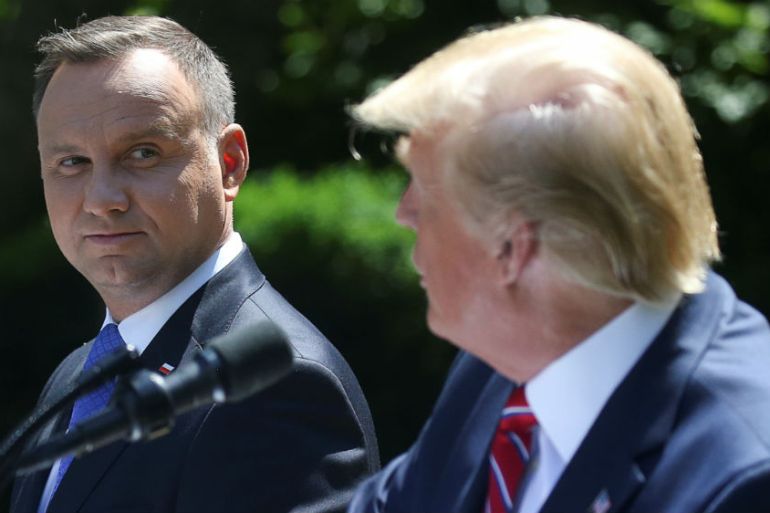After decades of waiting, Poles can visit the US without visas
The symbolic victory, however, comes at a price.

Warsaw, Poland – On November 11, Poland celebrates its independence day. This year, Poles can also savour another long-awaited liberty, as the country officially joins the United States Visa Waiver Program.
From Monday, Poles can spend up to 90 days in the US without a visa. Poland is the last Schengen country to qualify, as well as the first new entrant to the scheme in five years.
But much like the choice of date, the diplomatic success is mostly symbolic. The decision was administrative, and some worry that concessions were made to secure the announcement.
A decades-long wait
In the past two decades, speculation about when Poland would join the scheme had become something of a national pastime.
Back in 1991, Poland abolished visa requirements for Americans. When, a decade later, the US had still not reciprocated, Polish politicians began to lobby the White House.
To qualify for the waiver, the rate at which a country’s citizens are refused a US visa has to drop below three percent of applications. In 2006, Poland’s was still well over 25 percent.
Yet many felt that Poland’s support for the Iraq war had earned for the nation the right to be treated the same as Washington’s other European allies. The issue stung national pride and kept resurfacing in various political declarations and during bilateral talks.
“Poles are very pro-American,” Marcin Zaborowski, a senior associate at Visegrad Insight, told Al Jazeera.
“It influences our political decisions, such as participating in the wars in Iraq and Afghanistan. We back the US in the United Nations. We hosted a [US-led] Middle East Summit in February.”
The EU Commission had long applied pressure on the US for being the only country on the EU’s visa-free list which does not grant visa-free travel to all EU citizens. Yet the US remained unmoved – unlike Canada, which, under similar pressure, waived visas for all citizens of the EU in 2008.
A concerted diplomatic push only began in recent years, however. In 2017, refusals still stood at 5.92 percent and had fallen only as far as 3.99 percent in 2018, mostly due to Poles illegally taking up work and overstaying their visas.
LOT Polish Airlines, the country’s flagship carrier, is credited for launching an education campaign about choosing the correct visa type in a bid to cut refusal rates.
According to Dorota Dabrowska-Winterscheid, managing director at the American Chamber of Commerce in Poland, the final impetus came from Georgette Mosbacher, Washington’s ambassador to Warsaw
“[Ambassador Mosbacher] took lead of the issue, and became its face,” she told Al Jazeera. “Perhaps up until now, we were simply missing such a leader.”
Part of the ambassador’s plan involved persuading Polish businesses to send more official delegations to the US, as a means of lowering the refusal rate.
“During our meetings, she would speak about the problem and ask firms directly,” said Dabrowska-Winterscheid.
Marcin Zaborowski said that state-owned companies were heavily involved, suggesting that Polish tax-payers could end up footing the bill for the corporate diplomacy.
In September, Poland hit 2.76 percent refusals for the 2019 fiscal year, triggering the admissions process.
A bitter-sweet moment
A recent decision to boost the US military presence in Poland by 1,000 troops was “the cherry on top [of US-Polish relations] that we were missing”, said Professor Artur Wroblewski, a lecturer in American studies at Warsaw’s Lazarski University.
Visa slip-ups can now also be easier avoided, said analysts. “When there is a shareholders’ meeting in New York, and one of the Poles turns up with an outdated visa, it has always been hard to get it renewed fast enough,” said Dabrowska-Winterscheid.
Last year almost 107,000 Poles received tourist and business visas. From now on, temporary visitors will no longer pay $160 for a 10-year visa, but rather $14 to register in the Electronic System for Travel Authorisation.
Nevertheless, travellers will still go through immigration screening upon arrival in the US, which some fear could lead to more unvetted applicants being turned away at the country’s front door.
Anticipating more business and tourist traffic, American Airlines will launch its first route from Chicago to Krakow in 2020. LOT Polish Airlines has also pledged to increase the number of seats on current routes by 20 percent.
The price of free visas
News of Poland joining the scheme came just days before the October parliamentary ballot in which the incumbent Law and Justice (PiS) party was re-elected, setting off speculation about the price tag of the agreement.
“The timing of the announcement was decided to support the Polish government. I have no doubts about that,” Zaborowski told Al Jazeera.
“In exchange for the visas, which have little practical meaning, we were willing to offer to buy F-35 planes, which we do not need at all.”
During US Vice President Mike Pence’s visit in Poland in September, Poland also ditched plans for a digital tax, which it planned to levy on companies such as Google and Uber, and signed a cooperation agreement on 5G technology, cutting out Chinese tech leader Huawei.
Yet there could be something in this deal for Trump, too.
There are currently an estimated 10 million Poles in the US. And between two and eight percent of them (200,000 – 800,000) live across three key marginal states: Pennsylvania, which Trump won in 2016 by just 44,292 votes; Wisconsin, where Trump won by a margin of 22,748; and Michigan, which Trump took by a margin of just 10,704.
“The [visa] decision could actually help Trump’s campaign, as he stands for re-election next year, knowing that every vote will count,” said Wroblewski.